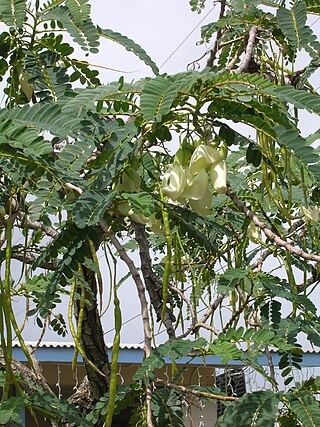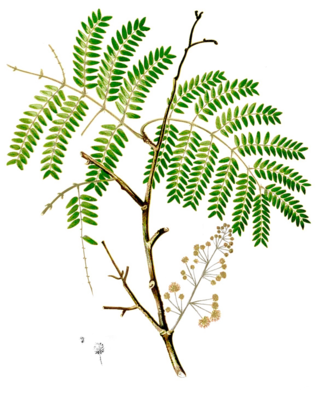
Pachyrhizus is a genus of flowering plants in the legume family, Fabaceae. It includes five or species of herbs and subshrubs native to the tropical and subtropical Americas, ranging from northern Mexico to northwestern Argentina. Typical habitat is seasonally-dry tropical forest and thicket, often at forest margins, in scrub vegetation, and in open grassy areas. Plants in the genus grow from large, often edible taproots.

Vicia faba, commonly known as the broad bean, fava bean, or faba bean, is a species of vetch, a flowering plant in the pea and bean family Fabaceae. It is widely cultivated as a crop for human consumption, and also as a cover crop. Varieties with smaller, harder seeds that are fed to horses or other animals are called field bean, tic bean or tick bean. Horse bean, Vicia faba var. equinaPers., is a variety recognized as an accepted name. This legume is very common in Southern European, Northern European, East Asian, Latin American and North African cuisines.

Senegalia greggii, formerly known as Acacia greggii, is a species of tree in the genus Senegalia native to the southwestern United States and northern Mexico, from the extreme south of Utah south through southern Nevada, southeast California, Arizona, New Mexico and western Texas to Baja California, Sinaloa and Nuevo León in Mexico. The population in Utah at 37°10' N is the northernmost naturally occurring Senegalia species anywhere in the world.

The winged bean, also known as cigarillas, goa bean, four-angled bean, four-cornered bean, manila bean, princess bean, star bean, kamrangi bean, pea, dragon bean, is a tropical herbaceous legume plant.

Phyllanthus acidus, known as the Otaheite gooseberry, Malay gooseberry, Tahitian gooseberry, country gooseberry, star gooseberry, starberry, arbari, West India gooseberry, Grosella, or simply gooseberry tree, is one of the trees with edible small yellow berries fruit in the family Phyllanthaceae. Despite its name, the plant does not resemble the gooseberry, except for the acidity of its fruits. It tastes sour and tart.

Castanospermum is a monotypic genus in the legume family Fabaceae. The sole species is Castanospermum australe, commonly known as Moreton Bay chestnut or black bean, which is native to rainforested areas on the east coast of Queensland and northeastern New South Wales, and to the southwest Pacific islands of Vanuatu and New Caledonia

Parkia speciosa, the bitter bean, twisted cluster bean, sator bean, stink bean, or petai is a plant of the genus Parkia in the family Fabaceae. It bears long, flat edible beans with bright green seeds the size and shape of plump almonds which have a rather peculiar smell, similar to, but stronger than that of the shiitake mushroom, due to sulfur-containing compounds also found in shiitake, truffles and cabbage.

Vachellia farnesiana, also known as Acacia farnesiana, and previously Mimosa farnesiana, commonly known as sweet acacia, huisache, or needle bush, is a species of shrub or small tree in the legume family, Fabaceae. Its flowers are used in the perfume industry.

Cordeauxia edulis is a plant in the family Fabaceae and the sole species in the genus Cordeauxia. Known by the common name yeheb bush, it is one of the economically most important wild plants of the Horn of Africa, but it is little known outside of its distribution area. It is a multipurpose plant, which allows the survival of nomads by providing them with seeds. Further, the bush serves forage for livestock, firewood and dye. Its wild population is currently declining. Because it is potentially valuable for other hot, dry regions as a resource for food and fodder, it is recommended to take measures against its extinction.

Acacia, commonly known as wattles or acacias, is a genus of about 1084 species of shrubs and trees in the subfamily Mimosoideae of the pea family Fabaceae. Initially, it comprised a group of plant species native to Africa, South America and Australasia, but is now reserved for species mainly from Australia, with others from New Guinea, Southeast Asia and the Indian Ocean. The genus name is Neo-Latin, borrowed from the Greek ἀκακία, a term used by Dioscorides for a preparation extracted from the leaves and fruit pods of Vachellia nilotica, the original type of the genus. In his Pinax (1623), Gaspard Bauhin mentioned the Greek ἀκακία from Dioscorides as the origin of the Latin name.

Sesbania grandiflora, commonly known as vegetable hummingbird, katurai, agati, or West Indian pea, is a small leguminous tree native to Maritime Southeast Asia and Northern Australia. It has edible flowers and leaves commonly eaten in Southeast Asia and South Asia.

Hodgsonia is a small genus of fruit-bearing vines in the family Cucurbitaceae.

Senegalia rugata is a spiny climbing shrub native to China and tropical Asia, common in the warm plains of central and south India. It is renowned as a raw material for shampoo, and the leaves and young shoots are often eaten. Archaeobotanical evidence shows its use for hair care in the pre-Harrapan levels of Banawali, some 4500–4300 years ago.

Vachellia nilotica, more commonly known as Acacia nilotica, and by the vernacular names of gum arabic tree, babul, thorn mimosa, Egyptian acacia or thorny acacia, is a flowering tree in the family Fabaceae. It is native to Africa, the Middle East and the Indian subcontinent. It is also considered a 'weed of national significance' and an invasive species of concern in Australia, as well as a noxious weed by the federal government of the United States.

Adenanthera pavonina is a perennial and non-climbing species of leguminous tree. Its uses include food and drink, traditional medicine, and timber.

Albizia lebbeck is a species of plant in the family Fabaceae, native to the Indian subcontinent and Myanmar. It is widely cultivated and naturalised in other tropical and subtropical regions, including Australia. Common names in English include siris, Indian siris, East Indian walnut, Broome raintree, lebbeck, lebbek tree, frywood, koko and woman's tongue tree. The latter name is a play on the sound the seeds make as they rattle inside the pods. Siris is also a common name of the genus Albizia.

Erythrina fusca is a species of flowering tree in the legume family, Fabaceae. It is known by many common names, including purple coraltree, gallito, bois immortelle, bucayo, and the more ambiguous "bucare" and "coral bean". E. fusca has the widest distribution of any Erythrina species; it is the only one found in both the New and Old World. It grows on coasts and along rivers in tropical Asia, Oceania, the Mascarene Islands, Madagascar, Africa, and the Neotropics.

Oroxylum indicum is a species of flowering plant of the monotypic genus Oroxylum in the family Bignoniaceae. It is commonly called Indian trumpet tree, oroxylum, Indian trumpet flower, broken bones, scythe tree or tree of Damocles. It can reach a height of 18 metres (59 ft). Various segments of the tree are used in traditional medicine.

Erythrina edulis (basul) is a nitrogen fixing tree that is native to the Andean region from western Venezuela to southern Bolivia. Nowadays it is known in Venezuela as "frijol mompás", in Bolivia, Peru and Northwest Argentina as "psonay", "pajuro", "sachaporoto del basul" or "poroto del sacha", in Colombia as "chachafruto", "balú", "baluy" or "sachaporoto" and in Ecuador as "guato". Although it is widely known, it is not commonly cultivated. Future research is needed, especially in agroforestry. Basul is a legume and so it produces protein-rich beans covered in pods which can be used for human or animal nutrition. The leaves and branches can be used as fodder. Besides the agricultural aspects, Erythrina edulis can also be used as a fence plant.

Lalab or lalap/lalapan (Indonesian) is a Sundanese raw vegetable salad served with sambal terasi. It is a popular Sundanese vegetable dish that originated in West Java and Banten, Indonesia.





















